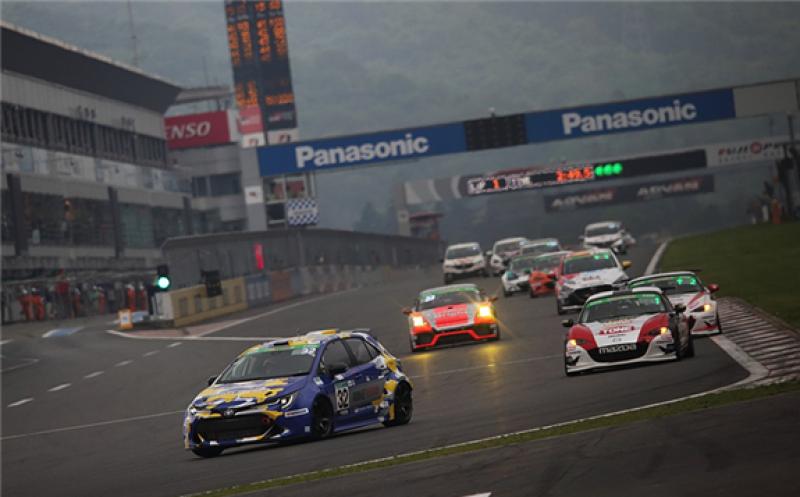The Rookie Racing-entered Corolla, which burns compressed hydrogen in its turbocharged 1.6-litre inline three-cylinder engine, completed a total of 358 laps in the Super Taikyu blue riband race at an average speed of 67.963km/h - less than half of the laps of the race-winning Nissan GT-R NISMO GT3.

Toyota FIA World Endurance Championship star Kamui Kobayashi and Toyota president Akio Toyoda, an occasional racer under the name 'Morizo', were among the six drivers sharing duties at the wheel of the ST-Q class entry, along with SUPER GT racers Hiroaki Ishiura, Takuto Iguchi and Takamitsu Matsui, and Super Taikyu specialist Masahiro Sasaki.
The Corolla completed the race with 35 pitstops (giving an average stint length of 10.2 laps), which were estimated to take around seven minutes each - meaning the car spent around four hours refuelling. Further time was also lost in the pits repairing an electrical issue in the night.
A special refuelling zone was set up in the paddock outside of the pitlane, with two large trucks and a series of tanks supplying the compressed hydrogen needed for the car to be able to complete the distance.
Sasaki set the car's fastest lap of 2m04.059s, slightly faster than the best lap set in the slowest ST-5 class (for modified production cars with a displacement of 1,500cc or less), but around 24 seconds slower than the outright fastest lap.
Toyoda said he hopes to use the Corolla project to accelerate the development of hydrogen cars, and show they can also play a role in helping societies reduce their carbon emissions alongside electric vehicles.
"The goal is simply to become carbon neutral," said Toyoda. "Since we made this statement, I, as the chairman of the Japan Automobile Manufacturers Association, have been asking the government to take the correct steps and increase the number of carbon-neutral options.
"This is because, if all cars become battery-electric, one million jobs will be lost in Japan.
"I believe we have an opportunity to demonstrate one of these [alternative] options here in motorsports. I want to tell the world there is also this option to become carbon neutral."
The Corolla differs from most other hydrogen motorsport projects, such as the ACO's 'Mission H24' programme, in that it uses an internal combustion engine and not a fuel cell. This means it produces a noise not dissimilar to a traditional gasoline-powered power unit.
Kobayashi, who made a single Formula E outing in the Hong Kong round of the 2017/18 season, said he hoped this would make hydrogen cars more appealing to fans than electric cars.
"I've raced petrol, hybrid and electric cars in the past and I thought, 'I really want this [hydrogen] to be used in motorsport in future'," said Kobayashi.
"The biggest problem with electric cars is the lack of noise. When I drove in FE, I was shocked to be able to hear the fans [over the electric motor]. But this car makes a noise. I really think it has a future."
Subaru SUPER GT regular Iguchi added: "I wouldn't know that I was driving a hydrogen car [if I wasn't told], and even now I can't quite believe it. It feels exactly like a normal car.
"I can control the car as I like, and I can feel the exhaust sound, engine sound, and vibration when I press the accelerator. I think it's amazing that we can do this while considering the environment."
Toyota Gazoo Racing president Koji Sato said that Toyota had adapted the engine from the GR Yaris road car for its hydrogen-powered Corolla, but with a decreased power output for durability reasons.
He explained hydrogen burns seven times faster than regular gasoline, putting much more strain on the engine's components, and that finding a way to make the engine lighter will be key to future performance gains.
"You don't need to do anything special to make a hydrogen engine; you can make a hydrogen engine by applying existing technology," Sato said. "Since it is loaded with safety and measuring equipment, it weighs about 200kg, so we will aim to reduce the weight and improve fuel efficiency.
"We could have done something different if we brought a 'polished' engine specifically for racing and aimed to win. But we are not trying to do that, we are trying to be carbon-neutral and show how we can connect existing automotive technology to the future."
GTNET Motor Sports secured a third overall Fuji 24 Hours win in four years, adding to its 2018 and '19 victories, with Takayuki Aoki, Kiyoto Fujinami, Natsu Sakaguchi and Nobuyuki Oyagi sharing the team's Daishin-liveried Nissan GT-R NISMO GT3 (pictured below).
They finished 42 laps ahead of the next-best GT3 car, D'station Racing Aston Martin Vantage of Satoshi Hoshino, Tomonobu Fujii and Tsubasa Kondo, and 35 laps on the ST-1 class-winning KTM X Bow that finished second overall.